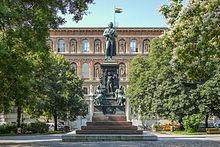Schillerplatz (Vienna)

The Schiller Place is a place in the Ring Road area of the first Viennese municipality district, Inner City . In its center is the Schiller Park.
history
The area of the square was once located as part of the unobstructed glacis outside the Vienna city walls and, after its demolition around 1860, was included in the planning for the ring road zone by the city expansion fund , whereby the city administration (in conflict of interests with the land users) advocated green spaces. The Kalkmarkt was previously located on the site of today's Schillerpark, which was relocated after the decision to build a square here. In 1870, according to a municipal council resolution, the square was named after the German classical poet Friedrich Schiller , already in view of the planned monument . In 1876 the Schiller Monument was erected, the center of the Schiller Park designed in 1877/78.
description
Schillerplatz is located between the streets of the Opernring and the Getreidemarkt . The rectangular square is bounded in the north by Elisabethstrasse , which runs parallel to the Ring and whose house numbers also exist on Schillerplatz. In the east of the square (the lane continues south in Makartgasse), in the south (where the Nibelungengasse, which is parallel to the Getreidemarkt , is interrupted by the square) and in the west (the lane continues south in Gauermanngasse ) there are house numbers of Schillerplatz. The entire area within the carriageway is taken up by the approximately 7000 m² Schillerpark. The Robert-Stolz-Platz adjacent to the north on the other side of Elisabethstraße forms a visual axis between Schillerplatz and Opernring or between the Schiller monument and the Goethe monument on the Ring.
The dominant building on Schillerplatz is the Academy of Fine Arts with an important picture gallery and graphic collection. The building was erected by Theophil Hansen from 1872 to 1877 .
The Schillerhof , built in 1870 by Johann Romano and August Schwendenwein , is at No. 1–2 . Until 1918 it was the seat of the Imperial Court of Justice, the highest court of justice of the kingdoms and states represented in the Imperial Council , and of the Imperial and Royal Railway Ministry . From 1919 on, the court was the seat of the Constitutional Court of the Republic of Austria. Since the courtyard to Schillerplatz has no gate, the entrances are around the corner , with the addresses Nibelungengasse 2-4 and Elisabethstraße 9.
All the buildings around the square are stylistically part of historicism .
Schiller Park
The Schillerpark is a historic park. It consists of symmetrical meadow rondeaus and has old trees. In the center of the park and square is the Schiller Monument , a bronze statue in a strictly historical style that was created based on a design by Johannes Schilling . The monument, which was unveiled in 1876, shows the statue of Schiller, the four ages of life, as well as allegorical figures symbolizing genius, poetry, science and the love of home. Friedrich Schiller was one of the first artists to whom a representative monument was dedicated in a public square in Vienna. Until then, this was usually only common for rulers or generals. In 1900, a Goethe monument was erected opposite the Schiller monument within sight on the Opernring.
In 1891, two more memorials by poets, both created by Karl Schwerzek , followed in the corners of Schiller Park . One is dedicated to Anastasius Grün , who was involved in the erection of the Schiller monument at the time, the other to Nikolaus Lenau . They are stone busts on steles with figures of geniuses at their feet.
Smaller than the other monuments and not in a corner of the park, but on the edge of the park, there is a bronze bust for the poet Josef Weinheber , which was created in 1940 by Josef Bock . It was only erected here in 1975 on a granite plinth by Heribert Rath. In 2010, Stephan Schmidt-Wulffen, Rector of the Academy of Fine Arts, requested the Vienna city administration to remove the monument because Weinheber was in favor of National Socialism.
The youngest monument in the Schiller Park was unveiled in 2000. It was created on behalf of Armenia and depicts the Austrian writer Franz Werfel , who with his novel The Forty Days of Musa Dagh memorialized the struggle of the Armenian people against their Ottoman oppressors. The sculptor Ohan Petrosjan created the bronze bust Werfels, Roland Martirosjan designed the granite pillar on which Armenian characters are carved and the inscription: In gratitude. The Armenian people.
The Schillerpark is mainly used by students from the academy and tourists. Even if it is smaller than many other green spaces in the inner city, the Schillerpark is one of the most remarkable parks in Vienna.
Adjacent to Schillerplatz, Robert-Stolz-Platz forms the connection to the Opernring. A memorial plaque for the operetta composer Robert Stolz is on a house on Schillerplatz, where it turns into Robert-Stolz-Platz. Proud once lived here.
literature
- Peter Autengruber : Parks and Gardens in Vienna . Promedia, Vienna 2008
- Felix Czeike : Historical Lexicon Vienna Vol. 5 . Kremayr & Scheriau, Vienna 1997
- Dehio Handbook Vienna. I. District - Inner City . Berger, Horn 2003
Web links
- Schiller- and Robert-Stolz-Park on the website of the City of Vienna
Coordinates: 48 ° 12 ′ 6.6 " N , 16 ° 21 ′ 55.4" E


